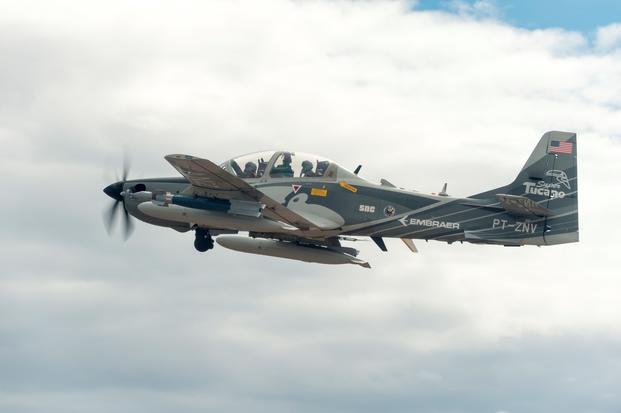An A-29 Super Tucano that crashed near Holloman Air Force Base, New Mexico, on Friday was part of the Air Force's ongoing light attack experiment, according to the service.
Officials said the crash occurred over the Red Rio Bombing Range at approximately 11:30 a.m. local time during a training flight, according to a release.
Two pilots were onboard. One aircrew member "suffered minor injuries and was airlifted to a local hospital," the release said. The Air Force did not disclose the condition of the second crewmember.
As a result of the crash, officials at the base cancelled additional flights for the light attack experiment for the day, according to a report from the Alamogordo Daily News.
Related content:
-
Senators Want $100 Million for New Marine Corps Light Attack Aircraft
-
The Air Force's Light Attack Search Won't Yield a New A-10. Here's Why
-
Congress Eager for Results of Air Force's Light Attack Aircraft Demo
Emergency response units from the White Sands Missile Range Directorate of Emergency Services initially responded to the crash. The Red Rio Bombing Range encompasses approximately 196,000 acres on White Sands Missile Range, the service said.
The Air Force did not initially disclose the type of aircraft involved in the mishap.
It is unclear if the crash could impact the remainder of Phase II of the light attack program.
Test units at Holloman are currently flying in the Air Force "light attack" experiment, an element of the service's effort to procure a new fleet of lightweight, inexpensive aircraft.
The Air Force selected two aircraft, the Textron Aviation AT-6 Wolverine and the Sierra Nevada/Embraer A-29 Super Tucano, to undergo more demonstration fly-offs, among other tests, at Holloman earlier this year.
The demonstrations began May 7 and will run through July, with Air Force Secretary Heather Wilson and Chief of Staff Gen. David Goldfein expected to fly either or both aircraft at the base.
The Air Force in 2016 announced that it had plans to hold flight demonstrations with a handful of aircraft to test whether lighter, "off-the-shelf" aircraft may be usable in ongoing wars such as Afghanistan.
Originally, four aircraft -- the Super Tucano, the AT-6, AirTractor and L3's AT-802L Longsword and Textron and AirLand LLC's Scorpion -- conducted live-fly exercises, combat maneuver scenarios and weapons drops during a demonstration at Holloman in August 2017.
In November, key lawmakers agreed to provide the Air Force with $400 million to continue experimenting with the planes.
-- Oriana Pawlyk can be reached at oriana.pawlyk@military.com. Follow her on Twitter at @oriana0214.













